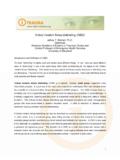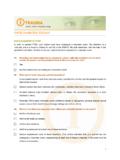Transcription of Critical Incident Stress Debriefing (CISD)
1 1 Critical Incident Stress Debriefing (CISD) Jeffrey T. Mitchell, Diplomate American Academy of Experts in Traumatic Stress and Clinical Professor of emergency Health Services University of Maryland Introduction and Definition of CISD: The term Debriefing is widely used and means many different things. In fact, there are many different types of debriefings in use in the world today. Most forms of Debriefing do not equate to the Critical Incident Stress Debriefing . One needs to be very careful and know exactly what type of Debriefing they are discussing.
2 Precision in the use of terminology is extremely important. Inaccurate definitions lead to faulty practice and flawed research. Critical Incident Stress Debriefing (CISD) is a specific, 7-phase, small group, supportive crisis intervention process. It is just one of the many crisis intervention techniques which are included under the umbrella of a Critical Incident Stress Management (CISM) program. The CISD process does not constitute any form of psychotherapy and it should never be utilized as a substitute for psychotherapy.
3 It is simply a supportive, crisis-focused discussion of a traumatic event (which is frequently called a Critical Incident ). The Critical Incident Stress Debriefing was developed exclusively for small, homogeneous groups who have encountered a powerful traumatic event. It aims at reduction of distress and a restoration of group cohesion and unit performance. A Critical Incident Stress Debriefing can best be described as a psycho-educational small group process. In other words, it is a structured group story-telling process combined with practical information to normalize group member reactions to a Critical Incident and facilitate their recovery.
4 A CISD is only used in the aftermath of a significant traumatic event that has generated strong reactions in the personnel from a particular homogeneous group. The selection of a CISD as a crisis intervention tool means that a traumatic event has occurred and the group members usual coping methods have been overwhelmed and the personnel are exhibiting signs of considerable distress, impairment or dysfunction. 2 The Facilitators The CISD is led by a specially trained team of 2 to 4 people depending on the size of the group.
5 The typical formula is one team member for every 5 to 7 group participants. A minimal team is two people, even with the smallest of groups. One of the team members is a mental health professional and the others are peer support personnel. A unique feature of CISD is that Critical Incident Stress Management trained peer support personnel (firefighters, paramedics, police officers, military personnel, etc.) work with a mental health professional when providing a CISD to personnel from law enforcement, fire service, emergency medical, military, medical, aviation and other specialized professions.
6 A peer is someone from the same profession or who shares a similar background as the group members. Police officers, for instance, who have been trained in Critical Incident Stress Management techniques, are selected to work with police officers who have been through the traumatic event. Fire service personnel with CISM background are chosen to work with firefighters and CISM trained emergency medical or military personnel will be placed on teams running a Critical Incident Stress Debriefing with their respective groups and so on.
7 Essential Concepts in CISD A Critical Incident Stress Debriefing is small group psychological first aid. The primary emphasis in a Critical Incident Stress Debriefing is to inform and empower a homogeneous group after a threatening or overwhelming traumatic situation. A CISD attempts to enhance resistance to Stress reactions, build resiliency or the ability to bounce back from a traumatic experience, and facilitate both a recovery from traumatic Stress and a return to normal, healthy functions.
8 The Critical Incident Stress Debriefing is not a stand-alone process and it is only employed within a package of crisis intervention procedures under the Critical Incident Stress Management umbrella. A CISD should be linked and blended with numerous crisis support services including, but not limited to, pre- Incident education, individual crisis intervention, family support services, follow-up services, referrals for professional care, if necessary, and post Incident education programs.
9 The best effects of a CISD, which are enhanced group cohesion and unit performance, are always achieved when the CISD is part of a broader crisis support system. Historical Perspective and Theoretical Foundations Critical Incident Stress Debriefing was developed by Jeffrey T. Mitchell, in 1974 for use with small homogeneous groups of paramedics, firefighters and law enforcement officers who were distressed by an exposure to some particularly gruesome event. It is firmly rooted in the crisis intervention and group theory and practices of such notables as Thomas Salmon, Eric Lindemann, Gerald Caplan, Howard 3 Parad, Lillian Rapoport, Norman Faberow, Calvin Frederick and Irvin Yalom.
10 The first article on CISD appeared in the Journal of emergency Medical Services in 1983. Over time, the use of Critical Incident Stress Debriefing spread to other groups outside of the emergency services professions. The military services, airlines, and railroads find the process helpful. This is particularly so when it is combined and linked to other crisis intervention processes. Businesses, industries, hospitals, schools, churches and community groups eventually adopted the Critical Incident Stress Debriefing model as an integral part of their overall staff crisis support programs.







